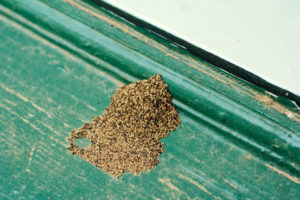 Hearing your property has a termite infestation can send chills down any property owner’s spine. The cost of ridding a property of termites can be out of budget for many folks. Dealing with them is also inconvenient because most cases involve fumigation to make sure that you’ve rid a structure of the whole colony. It’s no wonder that many opt to put off the problem. That’s especially easy to do because it’s a problem that is often occurring out of sight – making it easy to put it out of mind.
Hearing your property has a termite infestation can send chills down any property owner’s spine. The cost of ridding a property of termites can be out of budget for many folks. Dealing with them is also inconvenient because most cases involve fumigation to make sure that you’ve rid a structure of the whole colony. It’s no wonder that many opt to put off the problem. That’s especially easy to do because it’s a problem that is often occurring out of sight – making it easy to put it out of mind.
Sometimes we hear from homeowner associations that have a termite problem. In many of these cases the HOA has been ignoring the problem, which, as I mentioned before, is easy to do, even when you’re running an HOA. Many HOAs would rather spend money on improvements that are cosmetic in order to attract more people to purchase or rent from within the properties the HOA is overseeing.
Getting complacent when it comes to your termite problem is a bad idea. Termites are a social insect, living in colonies and taking care of one another. Like ants, each colony has a queen and eggs that the colony will take care of and protect. This means that the termites need a food source – that’s what makes your property a great nest for the colony. All that wood is a prime source for expanding the colony, which may contain thousands of workers. As the colony expands, it may form offshoots that form into new colonies within the same structure. More termites mean more damage.
Damage from drywood termites can be extensive. The National Pest Management Association reports that termites have contributed to more than $5 billion in annual damages in the United States. Their colonies infect foundations and wall studs. They damage structural wood, subfloors, floor supports, fence posts and more. They’ll also damage drywall, because as their nests begin to fill up with remnants from the colony’s waste, they’ll create tiny holes in the wall to expel it from the nests.
HOAs need to make sure that they are conducting annual inspections for termites, as the damage from ignoring problems associated with termites far outweighs the cost of inspection and early intervention. If your HOA does find that its properties have been infested with termites, you need to consult with a pest control company as well as a structural engineer. The pest control company can help you terminate the pest problem. Your structural engineer will help you evaluate the damage that’s been done and consult with you about whether a repair plan needs to be implemented.
Remember, just because there are no visible signs of a termite problem or the damage that a colony or multiple colonies may have caused, doesn’t mean that damage hasn’t been done. If you’re in charge of an HOA, you have a huge responsibility to ensure that any damage is identified and repaired. Termite damage could lead to structural instability, which could lead to further property damage, injuries or even worse.
At Helfrich-Associates we have dealt with many property owners that have experienced termite colony damage. We can work with you to diagnose any issues that have occurred due to damage as well as determine a course of action that will work for you and ensure your risk from the problem is reduced or eliminated.
Has your HOA had to deal with the fallout from a termite colony? Tell us your story in the comments area, below.
You can also join in on the conversation on our Facebook, Twitter or LinkedIn pages.
